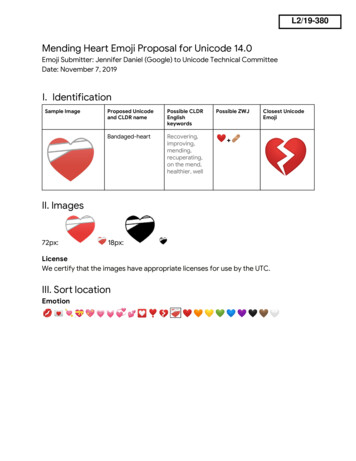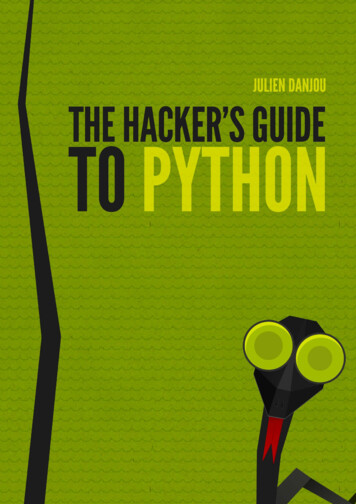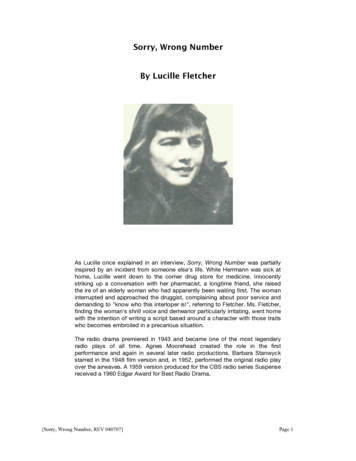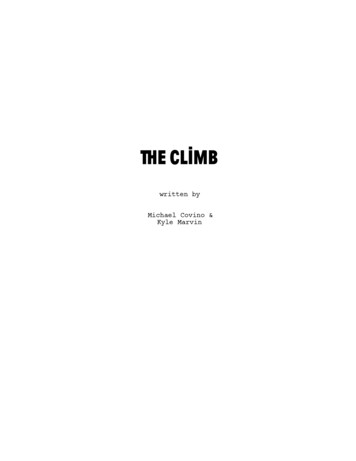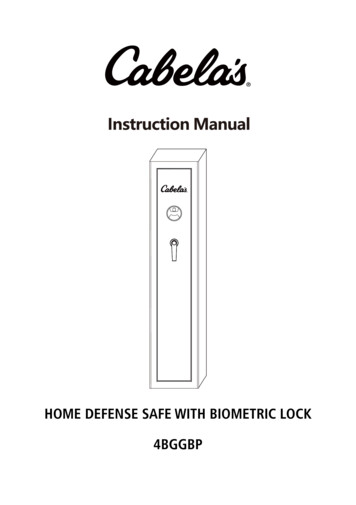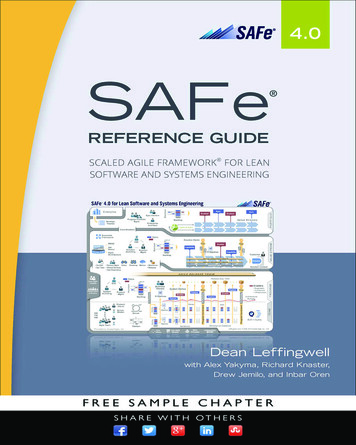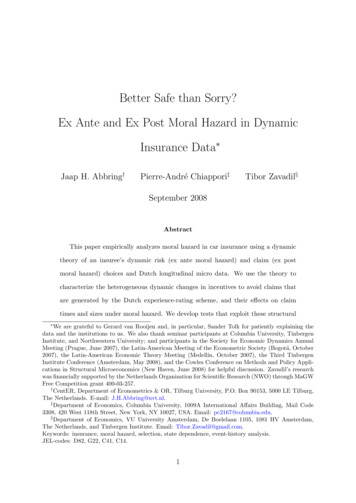
Transcription
Better Safe than Sorry?Ex Ante and Ex Post Moral Hazard in DynamicInsurance Data Jaap H. Abbring†Pierre-André Chiappori‡Tibor Zavadil§September 2008AbstractThis paper empirically analyzes moral hazard in car insurance using a dynamictheory of an insuree’s dynamic risk (ex ante moral hazard) and claim (ex postmoral hazard) choices and Dutch longitudinal micro data. We use the theory tocharacterize the heterogeneous dynamic changes in incentives to avoid claims thatare generated by the Dutch experience-rating scheme, and their effects on claimtimes and sizes under moral hazard. We develop tests that exploit these structural We are grateful to Gerard van Rooijen and, in particular, Sander Tolk for patiently explaining thedata and the institutions to us. We also thank seminar participants at Columbia University, TinbergenInstitute, and Northwestern University; and participants in the Society for Economic Dynamics AnnualMeeting (Prague, June 2007), the Latin-American Meeting of the Econometric Society (Bogotá, October2007), the Latin-American Economic Theory Meeting (Medellı́n, October 2007), the Third TinbergenInstitute Conference (Amsterdam, May 2008), and the Cowles Conference on Methods and Policy Applications in Structural Microeconomics (New Haven, June 2008) for helpful discussion. Zavadil’s researchwas financially supported by the Netherlands Organisation for Scientific Research (NWO) through MaGWFree Competition grant 400-03-257.†CentER, Department of Econometrics & OR, Tilburg University, P.O. Box 90153, 5000 LE Tilburg,The Netherlands. E-mail: J.H.Abbring@uvt.nl.‡Department of Economics, Columbia University, 1009A International Affairs Building, Mail Code3308, 420 West 118th Street, New York, NY 10027, USA. Email: pc2167@columbia.edu.§Department of Economics, VU University Amsterdam, De Boelelaan 1105, 1081 HV Amsterdam,The Netherlands, and Tinbergen Institute. Email: Tibor.Zavadil@gmail.com.Keywords: insurance, moral hazard, selection, state dependence, event-history analysis.JEL-codes: D82, G22, C41, C14.1
implications of moral hazard and experience rating. Unlike much of the earlierliterature, we find evidence of moral hazard.
1IntroductionFour decades of theoretical research on asymmetric information have firmly establishedits importance for insurance relations and competitive insurance markets. The practicalrelevance of this research, and of the results on the efficiency of insurance markets andthe design of optimal contracts that it has produced, depends critically on the empiricalrelevance of asymmetric information. A substantial and fast growing literature is nowassessing this relevance for a variety of markets, using microeconometric methods andmicro data on contracts and insurees. For some markets, notably car insurance, evidenceis surprisingly mixed and muted, often pointing to a lack of asymmetric information problems. Much of the literature, however, uses static theory and cross-sectional data, whichlimits both its versatility in dealing with truly dynamic aspects of insurance markets,such as experience rating, and variation in the data that can be turned into robust empirical results. The empirical distinction between moral hazard and selection effects usingstatic methods has turned out to be particularly hard; as argued by Abbring, Chiappori,Heckman, and Pinquet (2003), this is the standard econometric problem of distinguishingcausal and selection effects.This paper instead analyzes moral hazard in car insurance using panel data on contracts and claims provided by a Dutch insurance company. The analysis exploits someremarkable properties of the Dutch experience-rating system. Specifically, we theoreticallyanalyze the Dutch scheme as a repeated contract between an insuree and an insurer, inwhich each period’s interaction involves memory of the relationship’s past history. Usingcontrol theory, we study the endogenous changes this structure induces in the incentivesagents face at each point in time. Under moral hazard, these changes, in turn, generatespecific patterns in the time profile of claim occurrences and sizes that we fully characterize; these patterns are specific in the sense that they would not appear under the null of nomoral hazard. Finally, we develop structural econometric tests based on this theory andapply them to the Dutch micro data. The tests are flexibly parametric and nonparamet1
ric, and valid in the presence of unobserved heterogeneity of a general type. In contrastto much of the earlier literature, we find evidence of moral hazard in car insurance.We also discuss the empirical distinction between ex ante and ex post moral hazard. Exante moral hazard entails that agents respond to changes in incentives by changing the riskof losses. Ex post moral hazard concerns the effects of incentives on claiming actual losses.The distinction between ex ante and ex post moral hazard is important because of theirdifferent welfare consequences (e.g. Chiappori, 2001). Because an insurer’s administrativedata typically only contain data on claims, and not on losses, distinguishing betweenex ante and ex post moral hazard requires additional structural assumptions. Under areasonable set of such assumptions, we find that at least some of the detected moralhazard is due to ex post moral hazard.Our theoretical model specifies agent’s optimal dynamic savings, loss prevention effort, and claim choices under the experience-rating (bonus-malus) scheme in Dutch carinsurance. It produces predictions on the joint behavior of the claim occurrence, claimsize, and experience-rating processes, for given individual risk and other characteristics.Ex ante moral hazard is captured by the endogenous loss prevention effort; ex post moralhazard by the endogenous claim choice. Endogenous savings allow for self-insurance.The model provides a characterization of the dynamic heterogeneous incentives toavoid claims inherent to the Dutch experience-rating scheme, and their behavioral consequences under moral hazard. In particular, incentives are defined as the loss in expecteddiscounted utility that would be incurred if a claim would be filed. We show how incentivesvary with the current bonus-malus state and contract time, and jump with each claimbecause of its foreseeable effect on the future bonus-malus state. We present an algorithmfor numerically characterizing these effects and provide a quantitative analysis of incentives. We restrict attention to computations under the null of no moral hazard. Becauseclaim rates are constant under the null, these computations are relatively straightforward.Our tests for moral hazard build on these theoretical computations. We first focus on2
the timing of claims. Under the null that there is no moral hazard, claim rates do notvary with incentives; under moral hazard, on the other hand, claim rates are lower whenincentives are stronger. Our main test exploits the full model structure. It is a score(Lagrange multiplier) test for the dependence of claim rates on incentives in a version ofthe structural model that allows for flexible heterogeneity in risk. Because it only requiresthe computation of incentives under the null, it is easy to implement using our algorithm.We find strong evidence that claim rates decrease with incentives, and reject the null ofno moral hazard at all conventional levels.In addition to this structural parametric test for moral hazard, we also present andapply a range of nonparametric tests for state-dependence and contract-time effects onclaim rates, controlling for risk heterogeneity. Our theory implies that any such effectsmust be due to moral hazard and, in this way, identifies the substantial problem of testingfor moral hazard with the classical statistical problem of distinguishing state dependenceand heterogeneity. This is a hard problem, but one that has been studied at lengthin statistics and econometrics (Bates and Neyman, 1952, Heckman and Borjas, 1980,Heckman, 1981). Our tests rely on this literature’s key insight that, without contracttime and state dependence, the number of claims in a given period is a sufficient statisticfor the unobserved heterogeneity in the conditional distribution of claim times in thatperiod. Consequently, any signs of time or state dependence in subsamples with a givennumber of claims in a period are evidence of moral hazard. Moreover, an implication ofthe Dutch experience-rating system is that incentives may jump up or down at the time aclaim is filed, depending on the current bonus-malus state. Therefore, we not only test forstate dependence, but also for appropriate changes in its sign across bonus-malus states.Even though the nonparametric tests have relatively little power with the type of rareevents found in insurance data (Abbring and Zavadil, 2008), they corroborate the resultsfrom the structural test.Our theory also attributes a moral-hazard interpretation to state-dependence and3
contract-time effects on the sizes of claims. Under the assumption that ex ante moralhazard only affects the occurrence, but not the size, of insured losses, the latter are informative on ex post moral hazard. We complement this analysis of ex post moral hazardwith data on claim withdrawals. Agents in our data set can withdraw a claim within sixmonths and avoid malus. Under some assumptions, which we spell out in detail, claimwithdrawals are observed manifestations of ex post moral hazard.This paper contributes to a rich literature on asymmetric information in insurancemarkets. The seminal work on moral hazard and adverse selection by Arrow (1963),Pauly (1974, 1968), and Rothschild and Stiglitz (1976) showed that competitive insurancemarkets may be inefficient if information is asymmetric. A vast theoretical literaturefollowed up on their key insights. Increasingly, attention has shifted from the developmentof theory to the empirical analysis of its relevance (see, e.g., Chiappori, 2001, Chiapporiand Salanié, 2003, for reviews).1 Chiappori (2001) forwarded the idea to exploit therich variation that can be derived from dynamic theory and found in longitudinal data;Abbring, Chiappori, Heckman, and Pinquet (2003) suggested that we base a test formoral hazard on the dynamic variation in individual risk with the idiosyncratic variationin incentives due to experience rating.The empirical papers most closely related to ours are Abbring, Chiappori, and Pinquet (2003), Dionne et al. (2006), and Pinquet et al. (2007). Our analysis differs fromand extends these works in several ways. First, we precisely model the forward-lookingbehavior of an agent in the actual institutional environment characterizing the insurancemarket studied. We use this model to define and compute dynamic incentives and construct a structural test that exploits these computations in detail. Secondly, we explicitly1Car-insurance data were studied, among others, by Dionne and Vanasse (1992), Puelz and Snow(1994), Dionne and Doherty (1994), Chiappori and Salanié (1997), Dionne, Gouriéroux, and Vanasse(1999), Richaudeau (1999), Chiappori and Salanié (2000), Dionne, Gouriéroux, and Vanasse (2001), Abbring, Chiappori, and Pinquet (2003), Cohen (2005), Dionne, Dahchour, and Michaud (2006), Chiappori,Jullien, Salanié, and Salanié (2006), and Pinquet, Dionne, Vanasse, and Maurice (2007). Health and lifeinsurance data were analyzed by, for example, Holly, Gardiol, Domenighetti, and Bisig (1998), Chiappori,Durand, and Geoffard (1998), Cardon and Hendel (2001), Hendel and Lizzeri (2003), and Fang, Keane,and Silverman (2006). Finkelstein and Poterba (2002) studied annuities.4
distinguish ex ante and ex post moral hazard, which requires a formal analysis of the claimfiling behavior. Finally, we model both claim occurrences and claim sizes. Together, thisallows us to confront a novel and precise set of dynamic implications for claim occurrencesand sizes under moral hazard to longitudinal data.The remainder of the paper is organized as follows. Section 2 briefly discusses theDutch car-insurance market, with specific attention for the experience-rating scheme used.It also introduces the data. Section 3 develops the theory. We use the theory to analyze thedynamic incentives inherent to experience rating, and to derive the implications of moralhazard for claim rate and size dynamics. Section 4 develops an econometric frameworkfor testing the effects of moral hazard from data on claim rates and sizes and presentsthe empirical results. Section 5 concludes. Appendices A and B provide proofs andcomputational details for Section 3. Appendix C provides additional information on thedata.2Institutional Background and Data2.1Experience Rating in Dutch Car InsuranceIn 2006, the 16.3 million inhabitants of the Netherlands were driving 7.2 million privatecars.2 Because liability insurance is mandatory in the Netherlands, this comes with asubstantial demand for car insurance. In the same year, 74 insurance companies served thisdemand.3 Even though these companies are supervised by the Dutch financial authorities,they are to great extent free to set their premiums and contractual conditions. In doingso, the Dutch insurance companies, united in the Dutch Association of Insurers, have togreat extent coordinated their experience-rating systems in car insurance.Before 1982, car insurers employed a limited experience-rating scheme. This schemewas commonly considered to be inadequate to price observed risk. In the early 1980s, six23Source: Statistics Netherlands (www.cbs.nl).Source: Dutch Association of Insurers (www.verzekeraars.nl).5
of the market’s leading firms proposed a much finer bonus-malus (BM) system, based ona large actuarial study (de Wit et al., 1982).4 Early 1982, this system was introducedin Dutch car insurance in a coordinated way. After some early market turbulence, theinsurers by and large settled on similar bonus-malus schemes.This paper uses data from one of the six companies that were leading the introductionof the bonus-malus system in Dutch car insurance. During the data period, January1, 1995–December 31, 2000, this company used the bonus-malus scheme given in Table1. The premium discount depends on the insuree’s current bonus-malus class, whichis determined at each annual contract renewal date. Twenty bonus-malus classes aredistinguished, from 1 (highest premium) to 20 (lowest premium). Every new insureestarts in class 2 and pays the corresponding premium. We will refer to this premiumas the base premium. After each claim-free year, an insuree advances one class, up toclass 20. Each claim at fault sets an insuree back into a lower class. The worst class is1, and implies a surcharge to the base premium. This scheme is representative for thebonus-malus schemes used in the Netherlands in this period.5 Consequently, throughoutthis paper we assume that the drivers in our data set cannot escape Table 1’s bonus-malussystem by switching insurers.The empirical analysis in this paper exploits that the incentives to avoid a claim jumpwith each claim filed, and vary with contract time and across bonus-malus classes. To gainsome first insight in the differences in the “cost” of a claim to an insuree across different4Information on the development of the BM system in Dutch car insurance is scattered throughoutthe professional literature. de Wit et al. (1982) provides information on the actuarial research underlyingthe bonus-malus system, and some very early history. Assurantiemagazine (2004) provides more recenthistorical reflection.5The scheme is similar to the one originally proposed by de Wit et al. (1982), extended with multiple(maximum-bonus) levels that offer good customers some protection against premium increases. Evidenceon the development of the bonus-malus system is sketchy— see Footnote 4— but strongly suggests thatthe sector actively coordinated on similar bonus-malus schemes in the course of the 1980s, before the startof our data period. Moreover, further major innovations to car insurance pricing were only introducedrecently, after the end of our data period. We also compared Table 1’s scheme to schemes currentlyoffered by Dutch insurers and found only minor differences. The maximum discount on premium rangesfrom 70% to 80% and the maximum surcharge is in the range of 15% to 30%. Some insurance companiesoffer also collective insurance with more advantageous bonus-malus schemes.6
bonus-malus classes and different numbers of claims, we have computed the change in thepremium at the next renewal date with each claim in a contract year, for different bonusmalus classes. Table 2 gives the percentage premium change after a claim-free contractyear, and the subsequent marginal percentage changes in the premium after each claimin the contract year. For example, after a claim-free year in class 8, an insuree will beupgraded to class 9 and pay 45% instead of 50% of the base premium. This amountsto a 10% reduction in the premium. If she files one claim in the contract year, she willinstead be downgraded to class 4 and pay 80% of the base premium. This amounts toa (80 45)/45 78% increase relative to the premium that would be paid without theclaim. A second claim would take her down further to class 1, and a premium equal to120% of the base (a 50% increase relative to having one claim). A third claim would haveno further effect on the premium.Clearly, unlike the French scheme studied by Abbring, Chiappori, and Pinquet (2003),this scheme is not proportional. The premium increases after a first claim are largestfor those in the intermediate bonus-malus classes, and smallest for those in the top andbottom classes. The marginal premium increases after a second or third claim, however,are increasing nearly monotonically with the bonus-malus class, from 0% in the lowestclasses to 100–140% in class 20.6 This all suggests that incentives to avoid a claim jumpdown after a first claim for insurees in low classes and jump up after a first claim forinsurees in high classes. In Section 3, we formally define incentives in a dynamic theoreticalsetting and provide some numerical computations to formalize this intuition.Finally, note that insurees are contractually obliged to claim all their insured losses assoon as possible. However, the contract leaves them the option to withdraw their claimswithin six months from the loss date. Withdrawn claims do not count as at-fault claimsin determining the insuree’s bonus-malus class and therefore do not affect the premium.6In the lowest classes, therefore, the bonus-malus scheme itself does not give incentives to avoid asecond or third claim. However, the insurance company reserves the right to cancel contracts with threeor more claims at fault in a year. Because claims at fault are fairly rare, this is unlikely to affect insurees’decisions a lot. Therefore, we ignore contract cancelations in our theoretical and empirical analysis.7
Therefore, throughout most of the paper we treat withdrawn claims like unclaimed losses.That is, we ignore them, together with losses that were not claimed in the first place.Section 4.4 discusses the fact that withdrawals are in fact observed manifestations of expost moral hazard.2.2DataOur data provide the contract and claim histories of personal car insurance clients of amajor Dutch insurer from January 1, 1995 to December 31, 2000. The raw data consistof 1,730,559 records. Each record registers a change in a particular contract (renewal,change of car, etcetera), or a claim. The data include 75 variables, with informationon drivers (sex, age, occupation, postcode), cars (brand, model, production year, price,weight, power, etc.), contracts (coverage, bonus-malus class, level of deductible, premium,renewal date), and claims (type of claim, damage, etc.).The raw data contains 163,194 unique contracts. Because they do not contain information on claims in 1995, we excluded this year from the data. We also excluded thecontracts that are not covered by the bonus-malus system.7 This leaves 140,799 uniquecontracts with a total of 101,074 claims. Of these claims, 34,491 are claims at fault thatmay lead to a malus.8 However, in 2,463 of these cases, insurees have avoided a malusby withdrawing their claim.9 Throughout most of the paper, we treat withdrawn claimsas unclaimed losses, and simply exclude them from the analysis. Section 4.4 specificallystudies the withdrawal data to learn about moral hazard. Appendix C shows that theempirical results presented in the main text are robust to alternative ways of dealing withwithdrawals.7These are the contracts covering companies’ fleets of cars. Such contracts have no individual BMcoefficients, but general fleet discounts. These discounts are adjusted every year based on the fleets’ claimhistories.8The data also include so called “nil” claims, which are mostly pro forma claims of amounts belowthe deductible. These may correspond to an “at fault” event, but typically do not affect the agent’sbonus-malus status. Therefore, we treat all nil claims as claims not-at-fault.9We use both direct and indirect information to identify withdrawals. See Appendix C for details.8
We restrict our analysis to the claim histories from the contracts’ first renewal (orstart) date in the sample onwards. In the data, there are 124,021 contracts with observedrenewal date. Of these contracts, 6,787 were interrupted for some period of time. In thesecases, we only use the contract history from its first observed renewal date to its firstinterruption.For each contract, we registered the claim history, with information on the times andsizes of claims at fault that were not withdrawn. We examined the bonus-malus transitions between all observed contract years, corrected some inconsistencies (see AppendixC for details), and registered the initial bonus-malus class (i.e., the bonus-malus classestablished at the first renewal date). Along the way, we discovered that the data on thebonus-malus class after the 2000 renewal are not reliable.10 Therefore, we excluded contracts that started in 2000, and the history of ongoing contracts after their 2000 renewaldate.Our full final sample consists of 123,169 unique contracts with 23,396 claims at fault.Table 3 shows that many of these are observed for the maximum period of 4 years.We illustrate some of the data’s key features using only data on the first fully observedcontract years in the sample. Table 4 gives the number of contracts in this subsample bybonus-malus class and by number of claims at fault filed in the contract year. Contractswith one claim and contracts with two or more claims will be important, for differentreasons, to our empirical analysis. There are a lot of contracts with one claim in oursubsample but, because claims are rare, there are only 278 contracts with at least twoclaims.Figure 1 plots the distribution of contracts in our subsample across bonus-malusclasses. Classes 1 – 3 have less than 1% of the contracts each; more than 26% of thecontracts are in the highest class 20. The majority of contracts (over 57%) is in the highbonus-malus classes 14 – 20, where the premium is just 25% of the base premium.1040,104 out of 68,515 bonus-malus transitions in 2000 were incorrect.9
Figure 1 also plots the shares of contracts in our subsample with at least one and atleast two claims at fault, by bonus-malus class. These shares drop substantially with thebonus-malus class. It may be tempting to relate this variation in the number of claimsover bonus-malus classes to our discussion of incentives. However, the overall pattern canbe well explained by heterogeneity in risk, with high-risk individuals sorted into the lowerbonus-malus classes.3Model of Claim Rates and SizesThis section characterizes the dynamic incentives to avoid car insurance claims that areinherent to the Dutch bonus-malus scheme. We do so by analyzing a model of a single agent’s risk prevention and claim behavior that combines features of Mossin’s (1968)static model of insurance and Merton’s (1971) continuous-time analysis of optimal consumption. Our model is related to Briys (1986), but focuses on experience rating andits moral-hazard effects. It is an extension of Abbring, Chiappori, and Pinquet’s (2003)model with heterogeneous losses and endogenous claiming, carefully adapted to the Dutchinstitutional environment. Also, unlike Abbring et al.’s analysis of experience rating inFrench car insurance, we make the nonstationarity arising from annual premium revisionexplicit. This is important for our empirical analysis because in the Dutch bonus-malussystem, unlike in the French one, both the number of past claims and their distributionacross contract years matter for the current bonus-malus status.3.1PrimitivesWe consider the behavior and outcomes of an agent i in continuous time τ with infinitehorizon. Time is measured in contract years and has its origin at the moment the agententered the insurance market.The wealth of agent i at time τ is denoted by Wi (τ ) and accumulates as follows. At10
time 0, agent i is endowed with some initial wealth Wi (0) 0. Then, between τ andτ dτ , agent i receives a return ρWi (τ )dτ on her wealth and consumes ci (τ )dτ . Weignore any other income, such as labor income.11The agent causes an accident between τ and τ dτ with some probability pi (τ )dτ .12If so, she incurs some monetary loss. Denote the j-th loss incurred by agent i by Lij .We assume that Lij is drawn independently of the agent’s insurance history, including(Li1 , . . . , Li(j 1) ), from some time-invariant distribution Fi .13 The losses Lij are coveredby an insurance contract involving a fixed deductible Di and a premium qi (τ )dτ that ispaid continuously. The deductible is applied on a claim-by-claim basis, i.e. if a claim fora loss Lij is filed, the insurer pays Lij Di to the agent.The premium qi (τ ) is determined by agent i’s bonus-malus class Ki (τ ) according toTable 1. Thus, we can write qi (τ ) Ai (Ki (τ )), where Ai is a mapping from agenti’s bonus-malus class into her flow premium. Because the base premium to which thediscounts in Table 1 are applied depends on agent i’s characteristics, the mapping Ai willbe heterogeneous across agents.14Agent i is endowed with an initial bonus-malus class Ki (0). The bonus-malus class isupdated at the beginning of each contract year, the renewal date, according to the rulein Table 1. Thus, Ki (τ ) is a right-continuous process, with discrete steps at each renewaldate τ N depending on the past contract year’s bonus-malus class and number of claims.Denote by Ni (τ ) the number of claims in the ongoing contract year up to and includingtime τ . That is, Ni (τ ) is a claim-counting process that is set to zero at the beginning of11For the purpose of our analysis, this is equivalent to assuming that any such income is perfectlyforeseen by the agent (Merton, 1971, Section 7).12Accidents that are not caused by the agent are fully covered and have no impact on future premiums.Such accidents can be and are disregarded in our analysis. From now on, by accident or claim we alwaysmean accident or claim at fault.13This assumption is violated if agents can influence Fi ex ante by choosing to drive more or lesscarefully. Then, data on claim sizes do not distinguish between ex ante and ex post moral hazard, butare still informative on the overall presence of moral hazard.14Here, we abstract from time-varying characteristics other than Ki . There is not much harm in treatinge.g. age as a time-invariant characteristic, as our empirical analysis will focus on events in only one or afew contract years.11
each contract year. Then, at each renewal date τ N,Ki (τ ) B(Ki (τ ), Ni (τ )),(1)where Ki (τ ) and Ni (τ ) are agent i’s bonus-malus class and number of claims in thepast contract year, respectively, and B represents Table 1’s bonus-malus updating rule.Note that this rule is common to all agents. Recall that it moves agents who survivea contract year without claims to a higher bonus-malus class, corresponding to a lowerpremium, and all other agents to a lower class, with a higher premium.Insurance claims filed by the agent are potentially affected by ex ante and ex postmoral hazard (Chiappori, 2001). Ex ante moral hazard arises if the agent can affect theprobability of an accident. We model this by allowing, at each time τ , the agent to choosethe intensity pi (τ ) of having an accident from some bounded interval [pi , pi ], at a utilitycost Γi (pi (τ )). We assume that Γi is twice differentiable on (pi , pi ), with Γ0i 0, Γ00i 0.In words, reducing accident rates is costly and returns to prevention are decreasing. Fordefiniteness, we also assume that Γ0i (pi ) and Γ0i (pi ) 0. In addition, we allowfor ex post moral hazard by allowing the agent to hide a loss she has actually incurredfrom the insurer. For clarity of exposition, we assume that claiming and hiding losses arecostless, but that the agent cannot claim losses that have not actually been incurred.15The agent’s instantaneous utility from consuming ci (τ ) and driving with accident intensity pi (τ ) at time τ is ui (ci (τ )) Γi (pi (τ )). We assume that ui is strictly increasing andconcave. The agent chooses consumption, prevention and claiming plans that maximizetotal expected discounted utility16 Z ρτeE [ui (ci (τ )) Γi (pi (τ ))] dτ ,015Section 3.3.1 discusses a simple extension of the model in which hiding losses is costly. Such anextension is needed to formalize variation in the degree of ex post moral hazard in general, and theextreme case that agents report all losses (above the deductible) and do not suffer from ex post moralhazard in particular.16For simplicity, we assume that subjective discount rates equal the interest rate.12
subject to the intertemporal budget constraint limτ e ρτ W (τ ) 0 and given the wealthand premi
JEL-codes: D82, G22, C41, C14. 1. implications of moral hazard and experience rating. Unlike much of the earlier . This paper instead analyzes moral hazard in car insurance using panel data on con-tracts and claims provided by a Dutch insurance company. The analysis exploits some remarkable properties of the Dutch experience-rating system .
